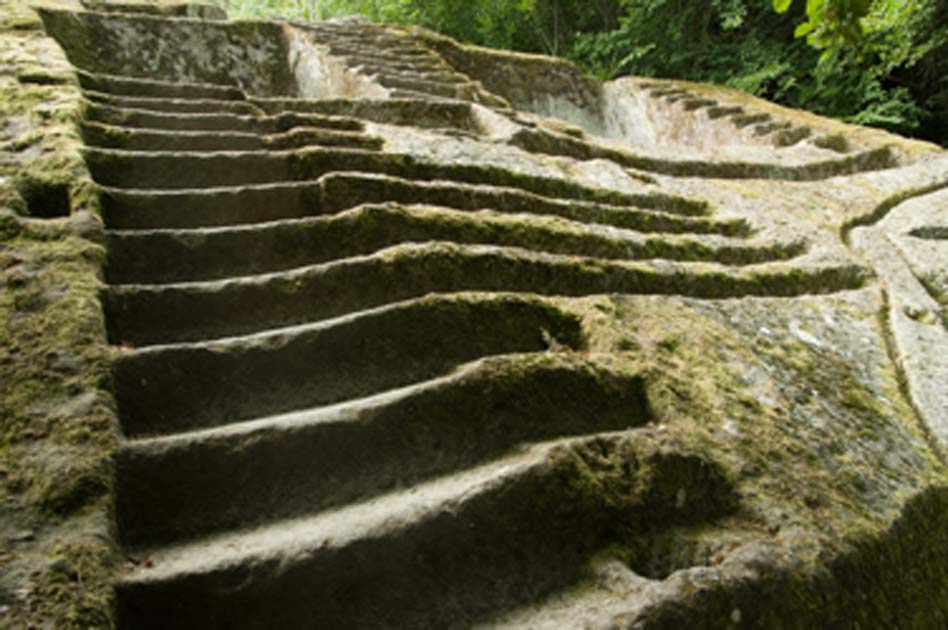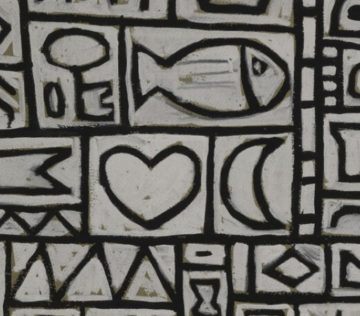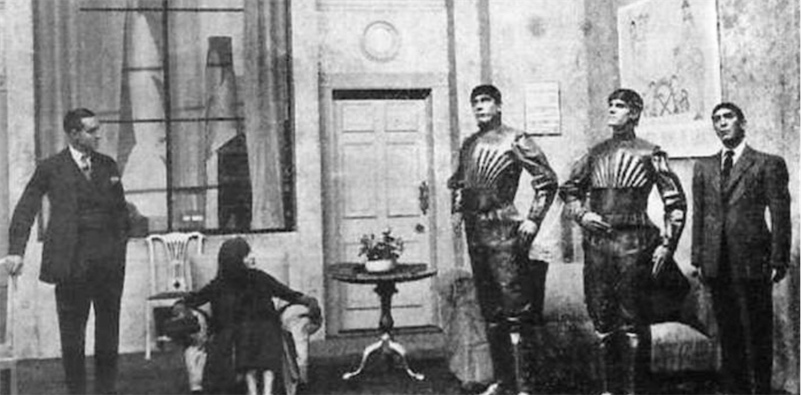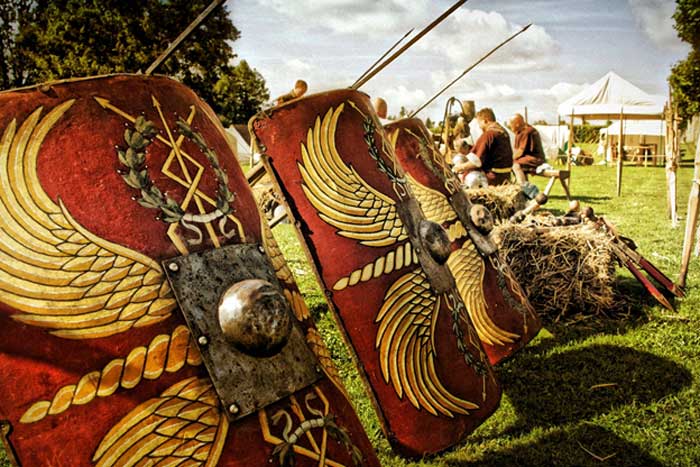via Ancient Origins by Aleksa Vučković

The steps of the ancient Bomarzo Pyramid. ( marcovarro / Adobe Stock)
The ancient and far-reaching history of Europe is often veiled in mists of mystery. Enigmatic peoples , diverse cultures , and strange legends are all left in the past, with not a lot left behind them to assemble a proper tale.
And one of these enigmatic cultures belongs to the ancient Etruscans. Once opulent and sprawling, the Etruscan civilisation met its end in the shadow of emerging Roman Republic . But without a doubt, this important culture left many traces in the Italian peninsula – traces that are uncovered even today.
Today we’re exploring a unique archaeological site – an enigmatic monument that speaks of the illustrious and intriguing past of the Etruscan civilisation and the distant corners of history that are covered in mystery. Let’s explore the pyramid of the Etruscans!
Continue reading
==============================
via Interesting Literature

All’s Well That Ends Well is one of William Shakespeare’s lesser-known and less highly regarded plays. Before we say more about the play – and how it came to be regarded as one of his ‘problem plays’ – it’s worth recapping the plot of All’s Well That Ends Well as a brief summary. This play, with its use of fairy-tale tropes and complex attitude to marriage and relationships actually has a fairly straightforward plot, thankfully.
Continue reading
Definitely not one of my favourites. Fairly straightforward the plot may be but some of it is simply implausible.
==============================
via Picture This: Library of Congress Prints and Photos by Kristi Finefield
This photo provides an unfamiliar view of a very familiar structure:

Washington Monument as it stood for 25 years. Photo by Mathew M. Brady, circa 1870. //hdl.loc.gov/loc.pnp/cwpbh.03248
Yes, that is the unfinished stump of the Washington Monument, as it looked for about 25 years. In 1856, when funding shortages interrupted construction, the monument stood only 156 feet tall out of a projected 500 feet. During the U.S. Civil War, the site was used for the grazing and slaughtering of government cattle, earning it the nickname Beef Depot Monument, as seen in this engraving (below left) published in Frank Leslie’s Illustrated Newspaper on Feb. 1, 1862. It was a rather ignominious period for the monument, after the cornerstone had been laid years before on July 4, 1848 to great fanfare in front of 20,000 people, with plans to build a design by architect Robert Mills.
Continue reading
==============================
via Boing Boing by David Pescovitz
This is the machine ballet of Lego minifigures getting made at a factory in Kladno, Czech Republic. Below, the molds behind a minifig.

(New Elementary)
==============================
via Ancient Origins by Nathan Falde

Illustration of an atom. Credit: Ezume Images / Adobe Stock
A few decades ago, who would have imagined that we’d be able to photograph a hydrogen atom? Given what we know about quantum mechanics, the whole concept would have been dismissed as absurd.
But in that creative nexus where science and technology merge, miracles can happen. The seemingly impossible can become reality, and that is exactly what happened in 2013 when an international team of scientists successfully captured an image of the hydrogen atom , in all its simple yet sublime glory.
Continue reading
==============================
posted by S. Abbas Raza in 3 Quarks Daily: Matt Dinan in The Hedgehog Review:

Universal Composition, 1937, Joaquín Torres-García (1874–1949); photograph: Philippe Migeat; Musée National d’Art Moderne, Centre Georges Pompidou, Paris, France; © CNAC/MNAM/Dist. RMN-Grand Palais/Art Resource, NY; © copyright Alejandra, Aurelio, and Claudio Torres 2017.
Teaching Augustine’s Confessions for the last five years or so, I’ve come to expect certain questions and objections:
Isn’t he awfully hard on babies? (No.)
Is it really a bad thing to cry when your mother dies? (Maybe not.)
Was he really such a terrible sinner? (Who am I to judge?)
But I was recently caught off guard when one of my students expressed uneasiness not with Augustine’s classical Christianity or his stringent understanding of morality but with his objections to the Roman practice of consulting astrologers. This student, it turned out, was one of many young people participating in what the New York Times somewhat antiseptically calls the “$2.1 billion mystic services market,” a market which, as one astrology app’s self-description puts it, “allows irrationality to invade our techno-rationalist ways of living.” In a follow-up conversation, my student suggested that his interest in astrology was “mostly ironic” – an observation in line with the wry tone adopted in many of the new online horoscopes.
Continue reading
==============================
via Interesting Literature
The plight of refugees is likely to evoke sympathy in all but the hardest of hearts, so it’s no surprise that some of the finest poets writing in English – including, naturally, some of the most politically aware – have written poems about refugees of different nationalities and the often harsh welcomes they’ve received when seeking a new home in a foreign country. Below, we’ve picked six of the best poems about refugees, spanning over 400 years of literature in English. Perhaps unsurprisingly, on this list we will find several English poets whose parents were of a different nationality.
Continue reading
==============================
via Boing Boing by David Pescovitz

In 1920, Czech writer Karel Čapek penned a play titled R.U.R., a cautionary tale about technology's potential to dehumanise.
R.U.R. stands for "Rossum’s Universal Robots" and it was this play that introduced the word "robot" to the world (apparently coined by Karel's brother Josef).
Continue reading
==============================
via Ancient Origins by Ashley Cowie

The remains of the Roman marching camp were uncovered during building work. Source: GUARD Archaeology Ltd / Fair Use.
A school playing field in Ayrshire, in the west of Scotland, has provided archaeologists with multiple layers of archaeology topped with a Roman marching camp used in the Roman conquest of Scotland.
Archaeological excavations undertaken by GUARD Archaeology prior to the building of the new Ayr Academy uncovered evidence of thousands of years of continued occupation. They unearthed traces of an Iron Age occupation with a shale bracelet , pits, and post-holes dating to the late third and second millennium BC, a Neolithic settlement from the fourth millennium BC, and a Mesolithic hunter/gatherer camp from the sixth millennium BC.
Continue reading
No comments:
Post a Comment